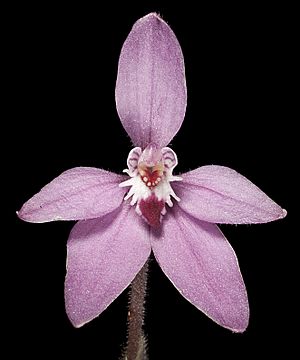Liitle pink fairy facts for kids
Quick facts for kids Liitle pink fairy |
|
|---|---|
 |
|
| Scientific classification |
|
| Kingdom: | Plantae |
| Clade: | Tracheophytes |
| Clade: | Angiosperms |
| Clade: | Monocots |
| Order: | Asparagales |
| Family: | Orchidaceae |
| Subfamily: | Orchidoideae |
| Tribe: | Diurideae |
| Genus: | Caladenia |
| Species: |
C. reptans
|
| Subspecies: |
C. r. subsp. reptans
|
| Trinomial name | |
| Caladenia reptans subsp. reptans |
|
| Synonyms | |
|
Caladenia preissii Endl. |
|
The little pink fairy or dwarf pink fairy (its scientific name is Caladenia reptans subsp. reptans) is a special kind of plant. It belongs to the orchid family, which is called Orchidaceae. This beautiful orchid only grows in the south-west part of Western Australia. It has one fuzzy leaf and can grow up to three small, pink flowers. Each flower has a special lip, called a labellum, which has three clear parts.
Contents
Discover the Little Pink Fairy Orchid
The little pink fairy orchid is a plant that grows from the ground. It is a perennial plant, meaning it lives for more than two years. It also has an underground tuber, which is like a storage part for food. These orchids often grow in groups, making them look like a small patch of flowers.
What Does the Little Pink Fairy Look Like?
Each plant has one hairy leaf. This leaf is usually about 4 to 8 centimeters (about 1.5 to 3 inches) long. It is also about 8 millimeters (0.3 inches) wide and has a purplish color on its underside.
The plant grows a stem that can be 5 to 15 centimeters (2 to 6 inches) tall. On this stem, you can find up to three flowers. These flowers are usually pale to dark pink. They are about 1 to 2 centimeters (0.4 to 0.8 inches) long and wide.
Flower Parts of the Pink Fairy Orchid
The top part of the flower is called the dorsal sepal. It stands upright and is about 1 to 1.5 centimeters long. The side parts, called lateral sepals, are similar in size. The petals are a bit smaller, about 0.9 to 1.4 centimeters long. They spread out like a fan, along with the side sepals.
The most interesting part is the labellum, or the flower's lip. It is about 6 to 7 millimeters long and 7 to 8 millimeters wide. This labellum has three distinct parts, or lobes. The side lobes often have three red stripes. The middle lobe has between four and ten short teeth along its edges. There are also two rows of thick bumps, called calli, running down the center of the labellum.
When Does the Little Pink Fairy Bloom?
These orchids usually flower from July to early October. If there has been a lot of rain, they might only bloom after a fire. But in drier areas, they can flower even without summer fires.
Naming the Little Pink Fairy Orchid
The scientific name for this orchid is Caladenia reptans. It was first described in 1840 by a person named John Lindley. He wrote about it in a book called A Sketch of the Vegetation of the Swan River Colony.
Later, in 2001, two scientists, Stephen Hopper and Andrew Phillip Brown, looked closer at this orchid. They described two different types, or subspecies, of Caladenia reptans. One of these was the subspecies reptans, which is what we are talking about here. They published their findings in a scientific journal called Nuytsia.
The word reptans comes from Latin. It means "creeping." This name was chosen because the orchid often grows in clumps, spreading out like it's creeping along the ground.
Where the Little Pink Fairy Orchid Lives
The little pink fairy orchid can be found across a wide area in Western Australia. It grows between the towns of Kalbarri and Esperance. You can find it in several different natural regions, including the Avon Wheatbelt, Esperance Plains, Jarrah Forest, Mallee, Swan Coastal Plain, and Warren areas.
It likes to grow in woodlands where jarrah and wandoo trees are common. It also lives in scrubland areas.
Protecting the Little Pink Fairy Orchid
The Western Australian Government's Department of Parks and Wildlife keeps track of plants and animals. They have classified Caladenia reptans subsp. reptans as "not threatened." This means that, for now, there are enough of these orchids, and they are not in danger of disappearing.

